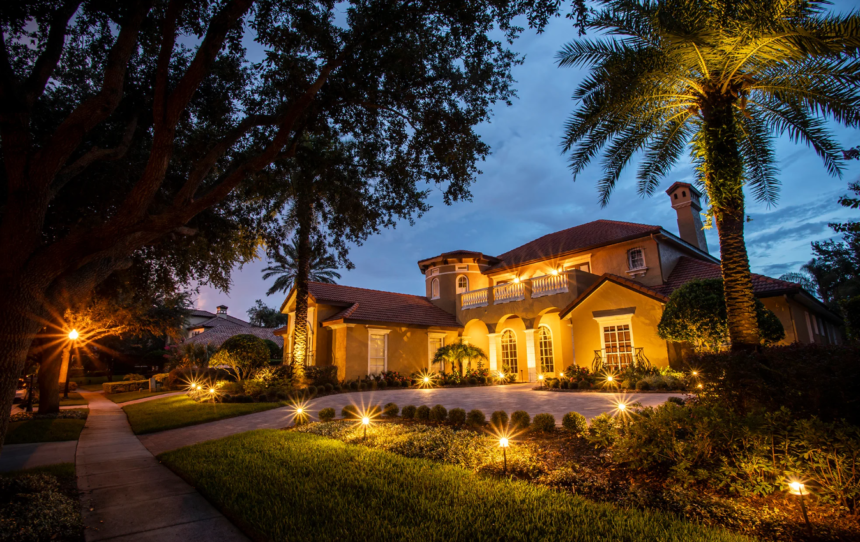Landscape lighting is a booming industry that’s only getting bigger. With more homeowners looking to enhance their outdoor spaces, the demand for professional lighting design and installation is skyrocketing. In fact, the landscape services industry is projected to grow over 4% annually through 2031.
In this article, we’ll explore the steps to start your own landscape lighting business. From developing a solid plan to providing top-notch customer service, we’ve got you covered. We’ll also touch on the option of franchising as a potential route to kick-start your venture.
KEY TAKEAWAYS
- Develop a comprehensive business plan to guide your landscape lighting company’s launch and growth.
- Secure all necessary licenses, permits, and funding sources before opening your doors.
- Invest in quality equipment, lighting products, and employee training from the start.
- Implement strategic marketing tactics and deliver exceptional customer service to stand out.
Step 1: Develop a Business Plan
Before starting your own landscape lighting business, having a solid business plan is step one. This plan acts as your roadmap and ensures you think through every aspect of starting and operating your company.
Your business plan should lay out the key details: an executive summary, an overview of your company, an analysis of your market and competitors, the lighting services you’ll offer and pricing, your marketing strategies, operational plans, and financial projections. Use it to clearly define your vision, goals, what makes your business unique, and how you’ll stand out.
Don’t skip this crucial step—your well-crafted plan will keep you organized and focused as you launch your new venture. Refer back to it regularly as a guiding light as your landscape lighting business grows. A comprehensive plan also shows lenders and investors that you are prepared and can help secure startup funding.
As an alternative path, you may want to consider franchising an existing landscape lighting business. With an established brand and operating systems already in place, franchising provides a head start. Many franchisors provide operations manuals and assist franchisees with developing their business plans.
Step 2: Obtain Necessary Licenses and Permits
Every business needs to play by the rules, and landscape lighting is no exception. Depending on your location, you’ll likely need a business license, contractor’s license, sales tax permit, and more. Requirements vary by state and municipality, so do your homework.
If you plan on doing any electrical work, you’ll probably need to be licensed as an electrician or master electrician. This involves passing an exam and meeting experience requirements in most areas.
If you opt for a franchise, the franchisor can guide you through the process for your specific territory. They’ll know exactly what you need to legally operate. However, you’ll still be responsible for obtaining the proper paperwork and staying compliant.
Step 3: Secure Funding
You can’t get the ball rolling without some startup cash. Initial costs for a landscape lighting business can range from $10,000 to $50,000 or more. Tally up the expenses for equipment, vehicles, inventory, insurance, marketing, and operating expenses for at least the first year.
Potential funding sources include personal savings, loans, investors, equipment leasing, or lines of credit. If you have great credit and existing collateral, traditional bank loans are an option. But be prepared to jump through hoops.
If you go the franchise route, the franchisor may provide financing assistance through their preferred lenders. They can guide you on estimated startup costs and offer discounts on things like equipment and inventory.
Step 4: Choose Your Equipment and Suppliers
As a landscape lighting pro, you’ll need an arsenal of tools: drills, trenchers, shovels, and more. You’ll also require a reliable vehicle to transport gear to job sites.
Perhaps most importantly, you need top-quality lighting products from trustworthy suppliers. Research vendors thoroughly, comparing prices, product lines, and customer service. Franchises often have established supplier relationships with vetted vendors, offering bulk discounts you may not secure on your own.
Step 5: Hire and Train Employees
Even if you start small, you’ll eventually need skilled employees to grow your landscape lighting business. Typical roles include lighting designers, installation crews, sales staff, administrative support, accounting, and more.
Take your time finding the right people who mesh with your company’s culture and values. Look for problem-solvers with a keen eye for detail and creativity. Develop comprehensive training programs to ensure everyone understands lighting design principles and installation best practices.
With a franchise, on the other hand, you’ll get staffing guidelines, training resources, and operational support to help you assemble and develop a top-notch crew. Many franchisors have extensive employee training programs you’ll implement.
Step 6: Provide Exceptional Customer Service
At the end of the day, happy customers are what matter most for any service business. Make stellar service your top priority every step of the way, from that first phone call to the final installation walk-through.
Train your team on communication skills, problem-solving, active listening, and going the extra mile. Implement systems for following up, handling complaints, collecting feedback, and constantly improving. Develop a customer satisfaction process and build it into your operations.
Many franchises have rigorous customer service standards and key metrics you’ll need to maintain, like response times, complaint resolution, and consumer reviews. But those high expectations breed long-term success and differentiate you from the competition.
Closing Thoughts
There you have it—the 7 key steps to launch your landscape lighting empire. With careful planning, the right team and partners, and an unwavering focus on customer satisfaction, you’ll be lighting up the neighborhood in no time. The market is ripe for skilled lighting professionals, so trust the process and don’t cut corners. If franchising feels like a fit, leverage that support system as you get started. Either way, your path to outdoor lighting success starts today!












